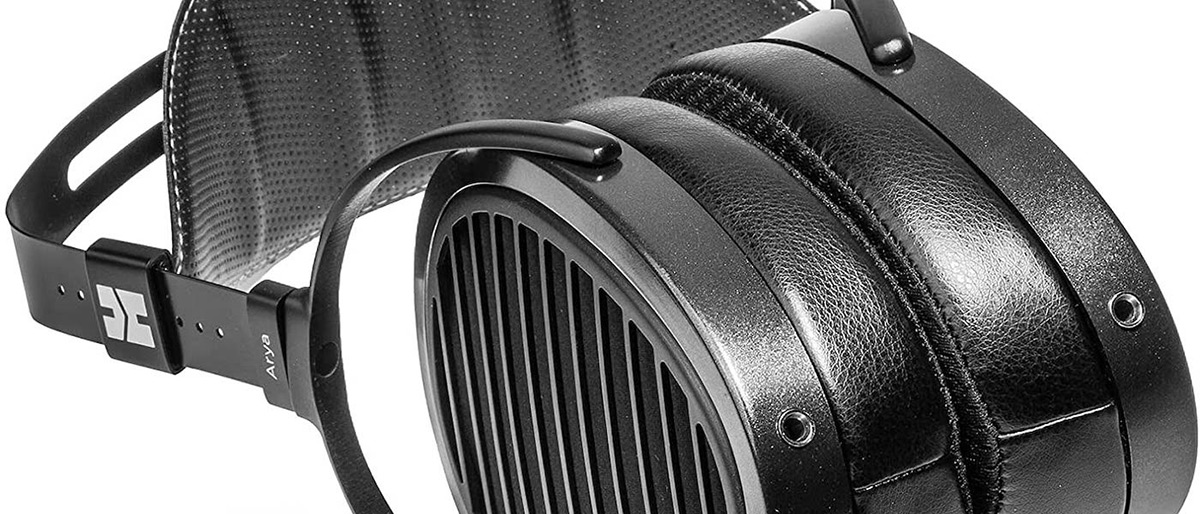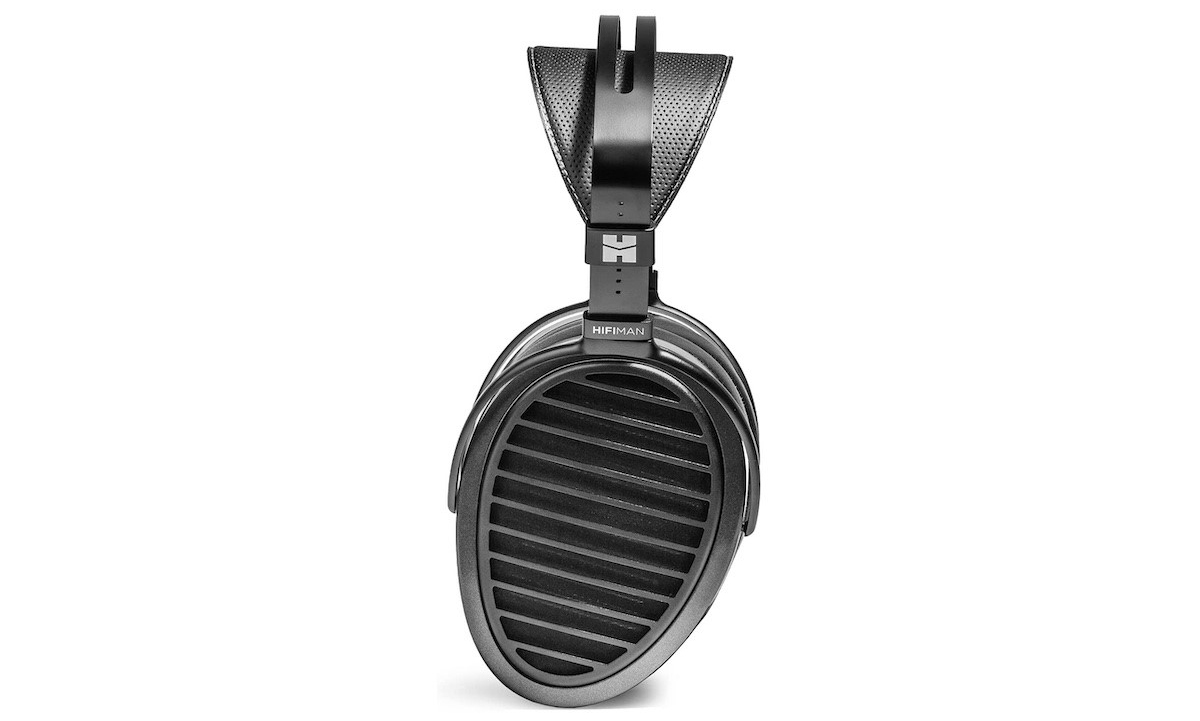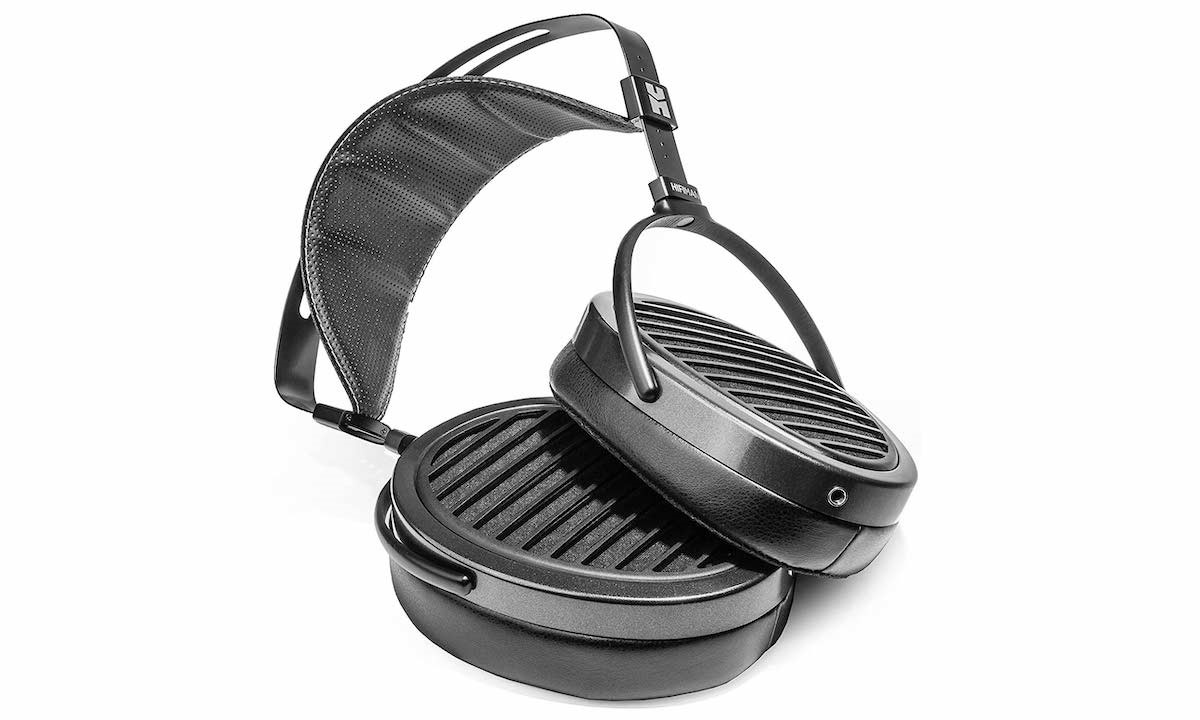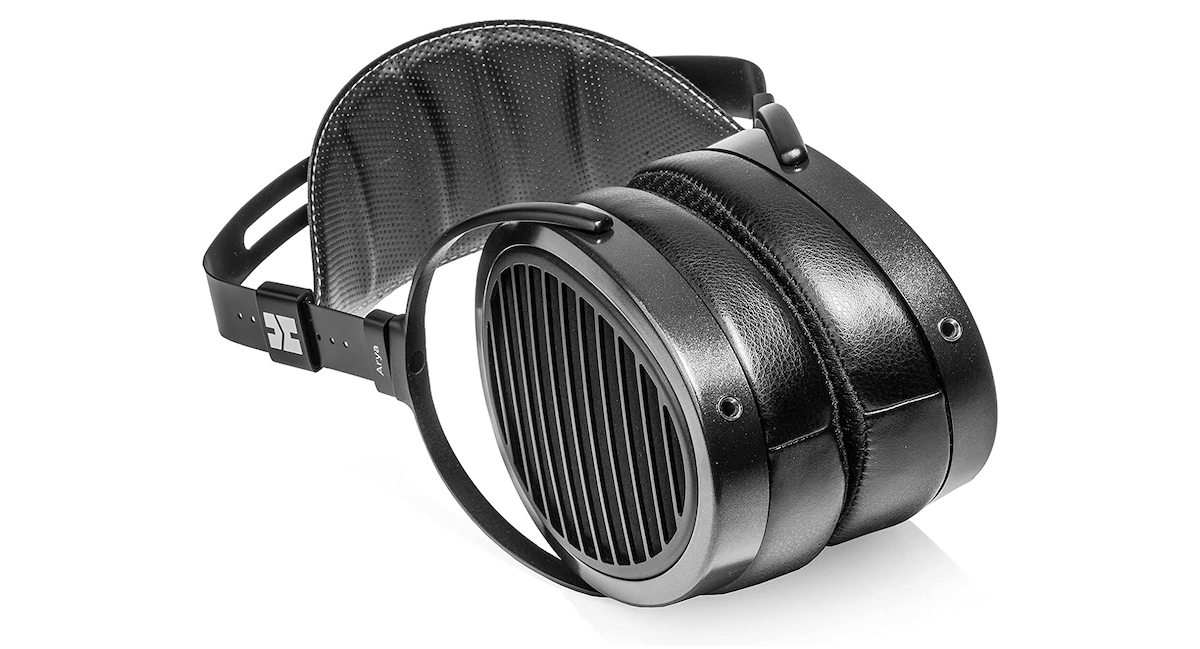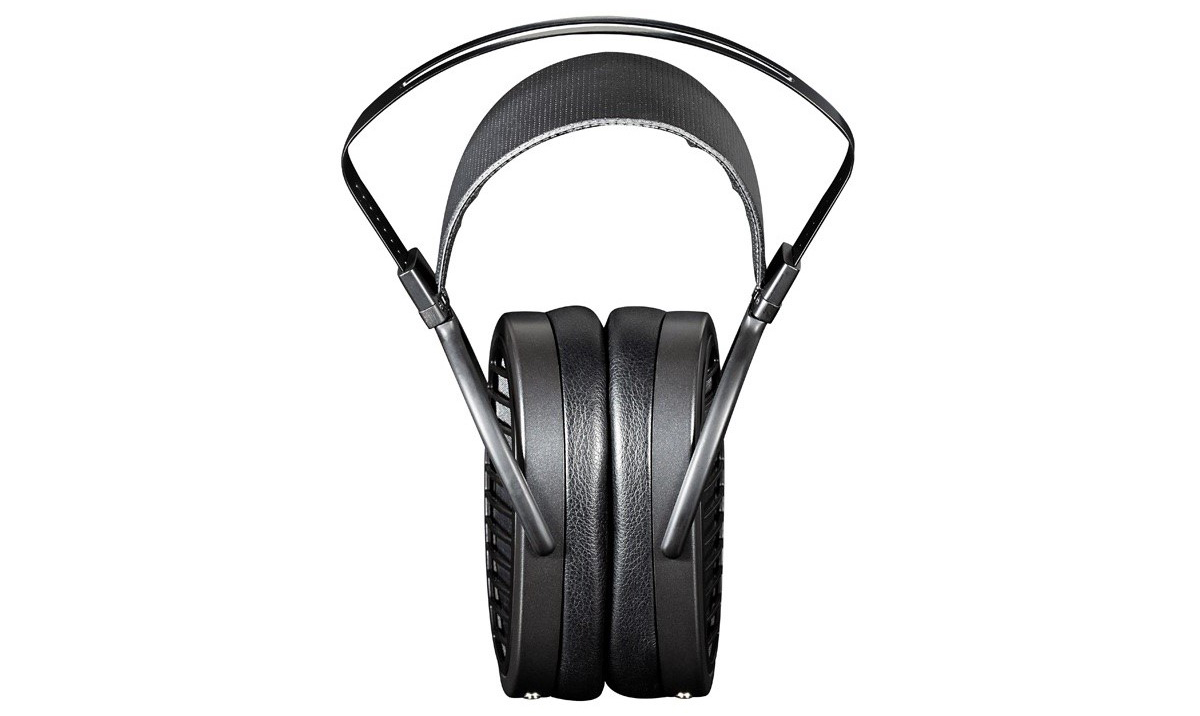HIFIMAN is a big player in the personal audio game, and they are not resting on their laurels. The Arya is an open-back planar magnetic headphone, and it has been updated with Hifiman’s recently developed Stealth Magnets. Dr. Fang Bian, president and CEO of HIFIMAN electronics claims that “this new technology improves upon earlier magnet designs by reducing interference beyond a point that wasn’t thought possible only a few years ago.” To achieve this, the Arya incorporates a Nanometer diaphragm that guarantees fast response and the bare minimum of distortion.
I listened to the Aryas with three different headphone amplifiers and found them quite comfortable and easy to drive. What surprised me is how good they sounded with an inexpensive headphone amplifier. What also surprised me is how truly good they are when paired with a high-quality headphone amplifier.
HIFIMAN Arya Stealth Magnet Planar Headphone
- Lightweight and comfortable design
- Fairly easy to drive
- Will reward you when paired with good-quality amplification
- Presents a huge sense of space while maintaining excellent detail retrieval
These are headphones with planar magnetic drivers. Instead of using the conventional cone driver attached to a circular magnet, these employ a thin flexible material suspended between the magnetic fields of a series of magnets. These planar drivers have more surface area to vibrate and project music into your ears than conventional cone drivers do. The flexible material used in the planar driver is much lighter than the material of a cone driver, which enables the planar driver to generate sound at a faster rate.
I do a fair amount of headphone listening with relatively inexpensive headphones, the Shure SRH840 ($129USD) and Sennheiser HD6XX ($240USD). These headphones aren’t particularly good at portraying microdetail or air around instruments, but what they lack in finesse they make up in utility. They generally don’t overemphasize upper and lower frequencies, on the whole, so they’re not likely to distract me with unnaturally imbalanced sound output. I have found that both pairs of these headphones become more engaging when they’re paired with an inexpensive headphone amplifier or DAC, like the Schiit Audio Fulla ($109USD) or the Audioquest DragonFly Red ($229USD), so I consider them good for listening for fun or background music, but when I’m interested in deep, careful listening, these headphones let me know I am missing a fair amount of the information available in the recording. It was the HIFIMAN Arya headphones that showed me that I could hear much more of the detail that’s really there in the recordings I listen to.
Secrets Sponsor
Design:
Circumaural, open-back headphones with planar magnetic drivers
Finish:
Black metal and high-grade plastic
Sensitivty:
94dB
Frequency Response:
8Hz to 65kHz
Nominal Impedance:
32 Ohm
Length and Type of Cable:
Single 1.5m long Crystalline Copper cable with 3.5mm mini stereo plug for each driver and ¼-inch phono plug termination, with black woven exterior finish
Connection:
3.5mm mini stereo jack on each driver
Weight (Without Cable):
15.2oz (430g)
MSRP:
$1,299 USD
Website:
Company:
SECRETS Tags:
Headphones, HIFIMAN, planar, stealth magnet, open-back, headphone reviews, Arya
Secrets Sponsor
The HIFIMAN Arya Stealth Magnet headphones are an update of the previous Arya open-back planar headphones. This new version features HIFIMAN’s recently developed Stealth Magnets, which feature a special shape that enables waves to pass through the magnets without generating interference.
HIFIMAN made a breakthrough discovery with the film materials used to make a planar magnetic headphone. Working with this material is extremely challenging, but HIFIMAN found a way to incorporate this film as the planar drivers in the Arya headphones. HIFIMAN also employs submicron-thick conductors on the planar film. These conductors are charged by HIFIMAN’s acoustically invisible Stealth Magnets. The design and orientation of these magnets reduce wave diffraction turbulence that can degrade the integrity of the sound waves. And that, in turn, reduces distortion to provide accurate and full-range sonic output.
The outer surface of the HIFIMAN Arya’s drivers are covered with HIFIMAN’s patented “Window Shade” system. These are a series of metal slats created to both protect the drivers and optimize the open-back design.
HIFIMAN supplies a single 1.5m long Crystalline Copper cable with a 3.5mm mini stereo plug for each driver and ¼-inch phono plug termination. The cable is wrapped with black woven material and feels sturdy and unlikely to come apart. But the cable is not attached to the headphones, so you can try others. Even though I only used the HIFIMAN-supplied cable, I like to think I could get better or different sound out of the Aryas with different cables. For example, I find myself wondering how they would sound with stranded silver wire or Kimble Kable woven cables.
Upon first glance, the HIFIMAN Arya Stealth Magnet headphones are big and their primary frame is metal. That immediately made me think they’d be pretty heavy, but they actually weigh in at just below one pound. The pads are circumaural, meaning that they completely cover your ears, and they’re asymmetrical, meaning they follow the natural shape of the human ear. The material of the earpads that surrounds your ears and rests against your head is soft and feels similar to velour, and a material like vinyl covers the pads’ exterior.
I wear glasses and don’t like the idea of having something heavy that constricts my head and puts pressure on the temples of my glasses. I have a pair of Bluetooth headphones that I use to listen to my Xbox Series X, and while they sound pretty good, they are quite heavy and give me a headache after wearing them for an hour or so. The Aryas did not cause me any pain, and that was after wearing them with glasses for hours on end. They are quite comfortable.
The HIFIMAN Aryas are 94dB sensitive with a 32-Ohm impedance. Let’s see how they sound with three different headphone amplifiers.
I started my time with the Aryas by listening to them with a Schiit Audio Fulla, a $109USD headphone amplifier, which I have plugged into my Apple iMac. I like to listen to music in the background when I work or surf the web, and I figured this would be a good test of the Arya’s comfort and compatibility with lower-priced headphone amplifiers. And the Aryas passed with flying colors. Even when wearing glasses, they never became uncomfortable or too heavy on my head. I could forget I was wearing them and concentrate on my web surfing or work.
For a reference song, I used Björk’s “All Is Full of Love” streamed via Qobuz in 16-bit/44 kHz (I sure wish we would get high-resolution two-channel versions of Björk’s catalog). I am not referring to the stripped-down version of the song found on her “Homogenic” album, but the “video version” of the song that was released on several CD EPs and DVD.
I think that Björk is someone who thinks of music in 3D terms and uses spatial effects effectively, even with two-channel recordings. This song in particular uses many sounds that circle around the listener’s head for a full 360 degrees. And there are also some particularly deep electronic bass notes in the song, which makes it great for testing the capabilities of a sound system or headphones.
The Schiit Audio Fulla costs $109USD. Its headphone output impedance is 0.5 Ohms, 200mW RMS for the Arya’s 32-Ohm impedance. Powered by the Fulla, the Aryas’ sound was comfortable across all frequency ranges. I found that none of the frequencies sounded particularly over-emphasized or under-represented. As sources, I listened to everything from YouTube, Qobuz streaming, and high-resolution FLAC files played with the VLC program, all with the Fulla connected to my 2017 Apple iMac via USB. I have configured the output of the iMac to two-channel 24-bit/96kHz.
Listening to the Aryas this way was an overall pleasant listening experience. It was not tiring, and if I shifted my attention fully to the music I was listening to, I found little to complain about. I’d estimate I heard only about 50% of musical information in the source material, but the Aryas were so balanced, and their soundstage so wide, that I didn’t really miss the detail all that much. But if I would try to stress the Aryas by turning up the volume to play some loud or heavy music, they got to work without breaking a sweat. When I would play electronic music with very low synthesized frequencies or heavy metal with bright cymbals and rapid kick drums, the Aryas never lost their composure. But there’s only so much a $109 headphone amplifier can do, so I knew I was not hearing quite a bit of microdetail.
This is the non-USB model of Benchmark’s venerable 2-channel, 24-bit/192kHz DAC. It dates from the year 2005. It features what Benchmark calls “the HPA2™,” which is a high-current, 0-Ohm headphone power amplifier. The music source was Qobuz played through a Raspberry Pi and attached to the DAC1 via S/PDIF cable.
Well, the DAC1 sure was powerful enough to drive the Arya headphones comfortably. Listening to the Björk cut, I was immediately surprised at the increase in the space and volume of the song. The soundstage of the Aryas through the DAC1 was much, much bigger and wider than I’d heard before. There was much more energy across the frequency spectrum, most particularly with the lower frequencies. The planar drivers of these headphones clearly like having a lot of power to get them moving. I could feel the entire surface area of the drivers exciting my ears as the music played. With the extra power behind them, the Aryas were much better at disappearing as the 3D sounds of the song circled around my head in the expanded soundstage. The lowest bass frequencies had a certain fuzz to them so that some notes lost focus as they decayed and blurred into other notes and lost their distinction. But, overall the Aryas gave me a much more engaging listening experience when driven by the Benchmark DAC1.
The Naim Uniti HE (headphone edition) is a DAC headphone amplifier, preamplifier, and streamer all enclosed in a single and very attractive black box with a full-color view screen. Its suggested retail price is $3,799 and I currently have one under review. I listened to the Björk cut streamed in Qobuz running through the Uniti HE’s native operating system.
Needless to say, the Uniti HE is the most advanced, and most expensive, component I had on hand to review the HIFIMAN Aryas, and I am very glad for that. While listening to the Aryas with the Schiit Audio Fulla was like seeing a single page of words on a printed page, listening with the Uniti HE was like opening the pages of a pop-up book and seeing words and pictures suddenly appear in front of my eyes. The music exploded into 3D realism, and the music just popped out and sprung into life. There was a huge increase in energy, micro detail, and soundstage. The Aryas had done a good job of portraying a soundstage and disappearing with the other two headphone amplifiers, but with the Uniti HE, the soundstage I was “seeing” in my brain went from the size of a bedroom to the size of a sports arena. And I felt like I went from seeing and hearing the music go around my ears and head into actually being inside the music. This was readily apparent with the Björk cut. The new microdetails gave the sounds that move around the soundstage shapes that I could see move around and next to and through other sounds as though they were all discrete birds. Listening went from pleasant to completely engaging and thrilling. And that is when I realized just how good the HIFIMAN Aryas can be.
At $1,599 USD, the Aryas are not cheap and would be a major expenditure for a lot of people, myself included. But they are well-built and sturdy and they sound good with a surprisingly wide range of headphone amplifiers.
- Comfortable to wear over extended periods of time
- Surprisingly easy to drive
- The Aryas provide engaging and detailed sound with both low- and high-powered headphone amplifiers
- These headphones will reward you when you pair them with better sound sources and headphone amplifiers
- Removeable cables
- Nothing
Before hearing the Aryas, I simply had never even considered spending this amount of money on a pair of headphones, but the Aryas helped me realize that it wouldn’t be such a bad idea. I enjoyed every minute I spent listening to music with them.
Another great thing about the Aryas is that the better you feed them, and the better you power them, the better they sound. These are headphones that will reward you when you start using a better headphone amplifier or upstream sources with them.
With the right source and headphone amplifier, the HIFIMAN Aryas can deliver an engrossing musical performance with power, subtlety, and nuance. You will hear quite a lot of microdetail and spatial cues as you find yourself lost in an expansive soundstage of musical experience. This is what I experienced with I paired the Aryas with the $3,799USD Naim Uniti HE, but the seventeen-year-old Benchmark DAC1 got me pretty close to that experience as well. And on top of all of that, they are comfortable. I wore them for hours on end with no discomfort.
If you are looking for a buy-it-for-life headphone purchase and a solid investment, then the HIFIMAN Arya Stealth Magnet planar headphones should definitely be on your short list. Just be prepared to realize you may want to upgrade other components in your system.



